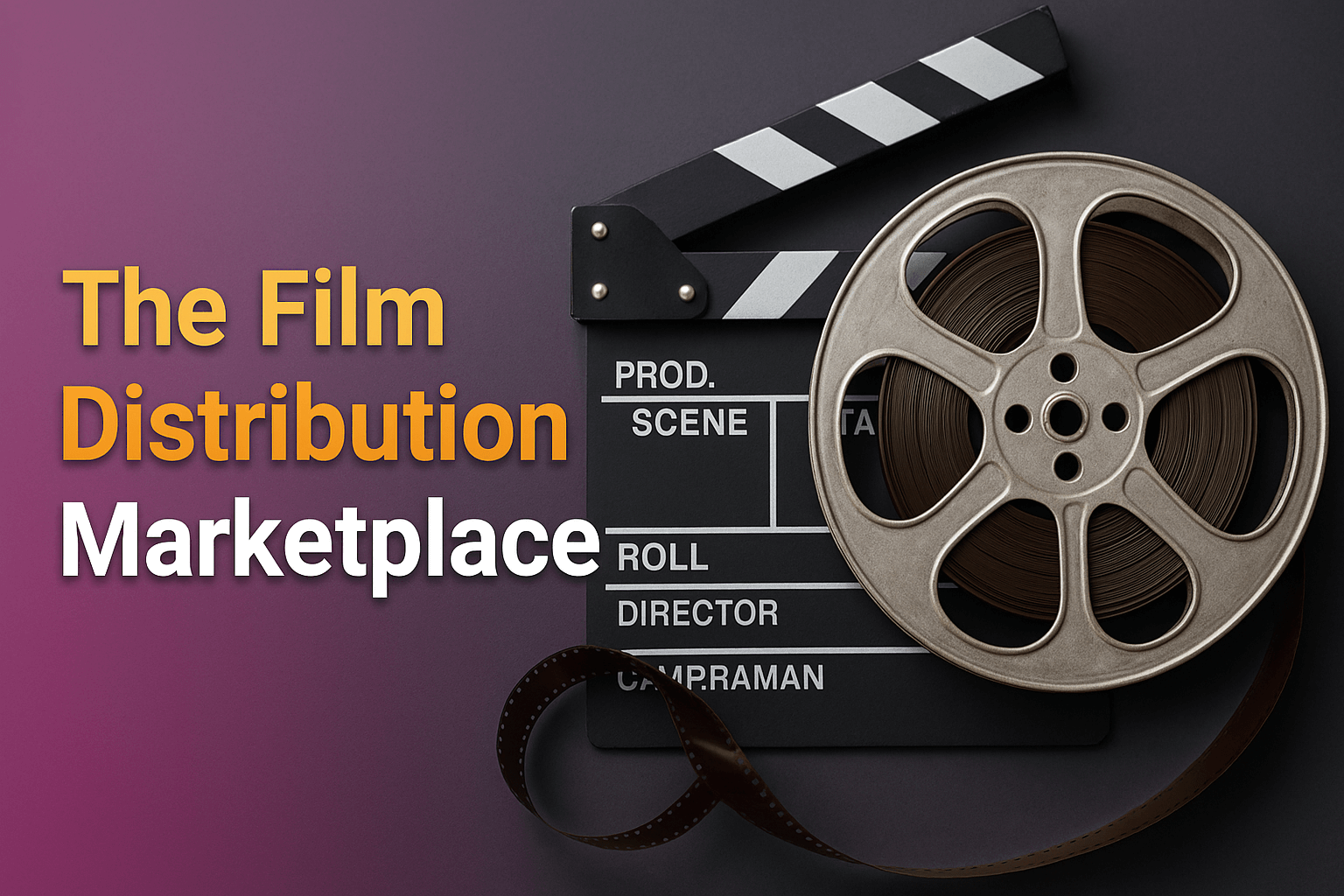The Film Distribution Marketplace: A Modern Executive’s Guide

Introduction
As an M&E executive, you know that the true business of film takes place behind the scenes—at the negotiation tables of the world’s film distribution marketplaces.
This term doesn’t refer to a single website or a solitary event; it is the entire, dynamic ecosystem where content is bought, sold, and financed. While a film’s creative merit is essential, its commercial success hinges on a leader’s ability to navigate this opaque and highly competitive environment. In my analysis, the core challenges for leaders today are not a lack of content, but a profound lack of actionable intelligence to identify, vet, and engage with the right partners.
This guide will provide a strategic lens for navigating this modern labyrinth, moving beyond tactical checklists to a holistic approach that prioritizes data and transparency to secure a profitable partnership.
Table of content
- The Film Distribution Marketplace: From Physical to Digital Hubs
- The Ecosystem of the Film Distribution Marketplace
- Core Challenges Facing the Modern Film Distribution Marketplace
- Vitrina’s Role in Navigating the Film Distribution Marketplace
- Conclusion: The Future of the Film Distribution Marketplace is Strategic
- Frequently Asked Questions
Key Takeaways
| Core Challenge | The film distribution marketplace is fragmented and opaque, making it difficult to find early-stage project intelligence and to efficiently vet partners. |
| Strategic Solution | Adopt a data-driven, intelligence-first approach to identify, vet, and engage with ideal distribution and financing partners. |
| Vitrina’s Role | Vitrina provides real-time, verified intelligence on the global entertainment supply chain, from project tracking to company profiling, to help you make informed decisions and secure the right deals. |
The Film Distribution Marketplace: From Physical to Digital Hubs
The film distribution marketplace has evolved from a series of exclusive, in-person events to a fluid, multi-channel ecosystem. For M&E executives, understanding this evolution is critical to building a profitable content strategy.
While a physical presence remains valuable for networking and relationship-building, the most effective strategy today is a blend of physical and digital engagement. As a strategist, I see three primary components of the modern film distribution marketplace:
- Physical Film Markets: Events like the American Film Market (AFM) and the European Film Market (EFM) are the world’s foremost hubs for deal-making. They are not festivals; they are high-stakes, professional trade shows where executives meet to buy, sell, and finance films. Attending these markets is a significant investment of time and resources, and the stakes are high, with over $1 billion in deals often sealed at the AFM alone. Their value is in the concentration of decision-makers in one location, facilitating rapid negotiations and screenings.
- Digital Platforms and Aggregators: The rise of digital-first distribution has created new online marketplaces. Platforms like FilmHub or indie film aggregators act as a conduit, connecting finished films to hundreds of digital outlets and VOD services. While they simplify the technical delivery process, they don’t actively “sell” your film. For a leader, they are a tactical tool for direct-to-consumer strategies, not a replacement for strategic sales agents.
- The Global Ecosystem: Beyond the marquee events and digital platforms, the true marketplace is the network of relationships and deals happening every day. This includes private deals between major studios, bilateral agreements between production companies and streamers, and the ongoing work of sales agents who are constantly pitching and negotiating on behalf of their clients.This is the most opaque and challenging component to navigate, as it lacks a central hub or public-facing directory. According to a report from Research and Markets, the global film and video market is expected to grow to $417.99 billion by 2029, a trend driven largely by the proliferation of these digital and global distribution deals.
The Ecosystem of the Film Distribution Marketplace
To successfully operate in the film distribution marketplace, an executive must understand the roles of the key players. Each has a distinct function and a place in the complex value chain:
- Sales Agents: These are the bridge-builders. A sales agent, or international sales agent, represents the rights holder and sells a film’s license to various distributors on a territory-by-territory basis. Their value lies in their existing relationships with both major and niche distributors globally. They handle complex negotiations and legalities, often taking a significant percentage (15-40%) of the gross revenue. A reputable sales agent is often the most common way to get a film in front of a major streamer like Netflix.
- Content Acquisition Executives: This is the person on the other side of the deal. They are responsible for acquiring films for their company’s library, be it for a streaming platform, a broadcast network, or a theatrical distribution company. Their primary challenge is efficient scouting and discovery, as they must sift through thousands of potential projects to find the few that align with their business goals.
- Distributors: A distributor is the company that acquires the rights to a film from the sales agent and handles the marketing and exhibition of the film to the public. They are the engine of the entire process, responsible for getting the film onto screens—be it in a cinema or on a viewer’s device.
Core Challenges Facing the Modern Film Distribution Marketplace
In my experience, the greatest bottleneck in the film distribution marketplace today is not a lack of content, but a lack of transparency and an excess of competition. For M&E executives, this translates into several critical pain points:
- Early-Stage Project Visibility: The most sought-after content is often identified and optioned long before it is publicly announced or brought to a film market. Executives who rely on traditional scouting methods often find themselves late to the negotiation table, competing for finished films instead of securing pre-buy or financing deals.
- Opaque Partner Vetting: Once a potential partner (like a sales agent or distributor) is identified, the process of vetting their track record and relationships is often manual. There is no centralized source to confirm their past deal history, their genre specialization, or their key contacts. This lack of transparency leads to inefficient outreach and a higher risk of engaging with the wrong partner.
- Inefficient Discovery: The cost and time required to travel to major film markets multiple times a year is prohibitive. Relying on these physical events for a comprehensive view of the global marketplace is no longer a sustainable business model. The industry needs a more efficient, scalable method for constant discovery and intelligence gathering.
Vitrina’s Role in Navigating the Film Distribution Marketplace
As a strategist, I analyze the tools and platforms that provide a genuine competitive advantage. In the modern landscape of the film distribution marketplace, where data and partnerships are everything, Vitrina serves a crucial function. Its core value proposition is the centralization of verified, executive-level intelligence that was previously fragmented across dozens of sources.
It is the missing piece of the puzzle for leaders seeking to scale their distribution efforts with precision. According to the provided documentation, Vitrina addresses the core pain points of M&E executives by providing a solution that is:
- Proactive: Vitrina’s Film+TV Projects Tracker provides an early warning system, allowing you to discover upcoming film and TV projects in development or production long before they are presented at a market. This gives you a significant advantage in securing financing, pre-buys, or co-production deals.
- Precise: With the ability to search and filter over 2.7 million companies and more than 3 million executives, you can quickly find international distribution partners aligned by genre, scale, and region. You can move from a general search to a targeted outreach with confidence.
- Connected: The platform goes beyond simple data. It maps and validates the partnerships and deal track records between companies, allowing you to see their collaborative history and reputational alignment before you even make a call.
Conclusion: The Future of the Film Distribution Marketplace is Strategic
The era of hoping for a big break at a film festival or blindly pitching to hundreds of distributors is over. The executives who will lead the industry forward are those who treat their presence in the film distribution marketplace not as a reactive, logistical process, but as a strategic business function powered by data and intelligence.
The market has shifted, and the onus is now on producers and executives to be more informed, more targeted, and more proactive than ever before. In my analysis, the path to a successful distribution deal is a function of knowing who to talk to, when to talk to them, and what they are looking for.
For leaders seeking to navigate this complex landscape, a new strategic imperative has emerged: you must have a holistic view of the entertainment supply chain. From the earliest stages of a project’s development to its final release, real-time, verified intelligence is no longer a luxury—it is the foundational tool for securing partnerships and ensuring the commercial viability of your content.
By adopting this intelligence-led approach, you are not just selling a movie; you are building a sustainable, data-driven engine for your entire business pipeline. For more insights on leveraging this technology, I recommend exploring other analyses on strategic dealmaking and the future of content acquisition.
Frequently Asked Questions
A film distribution marketplace is not a single location, but a collective term for the physical events (like AFM), digital platforms, and the global network of companies and professionals where films are bought, sold, and licensed for distribution to various audiences worldwide.
A sales agent is a crucial intermediary who represents the rights holder and sells a film’s distribution rights to various international distributors. They leverage their network and market expertise to secure deals, manage legalities, and maximize revenue for the rights holder.

























